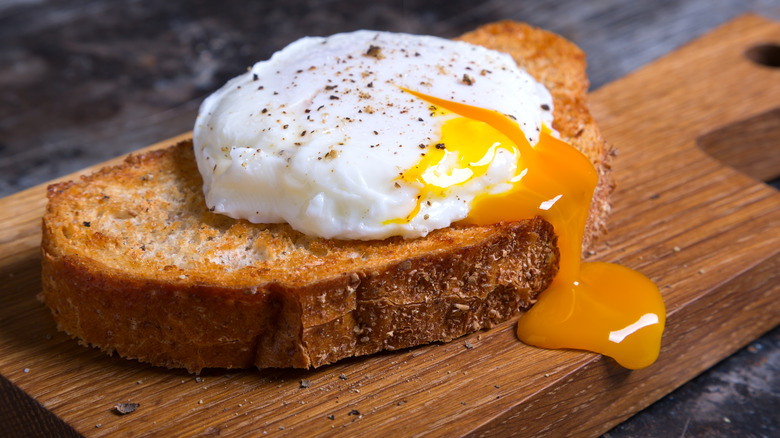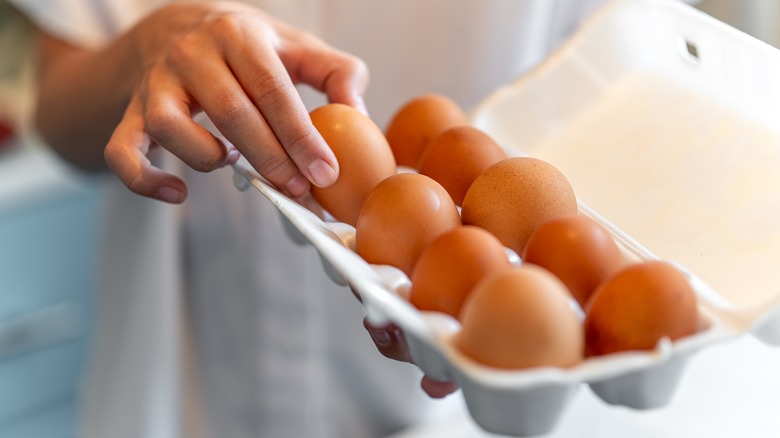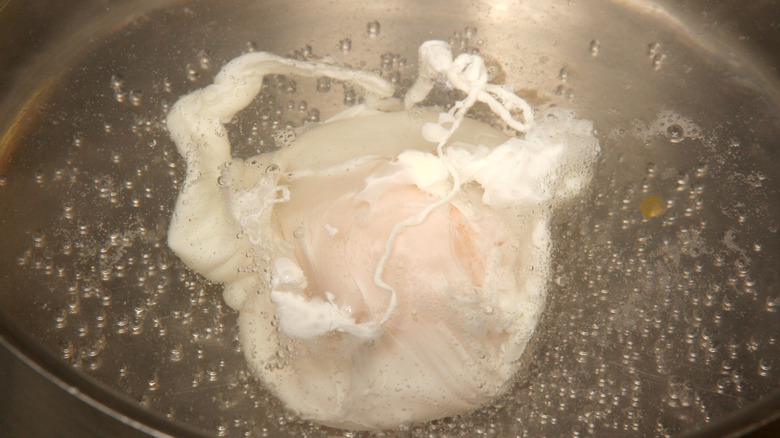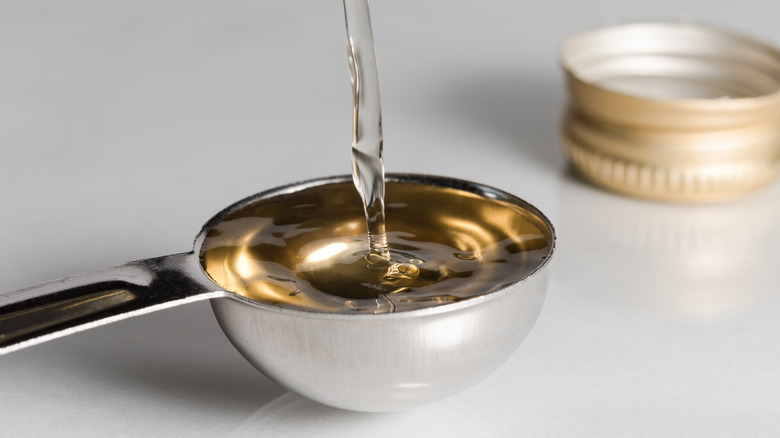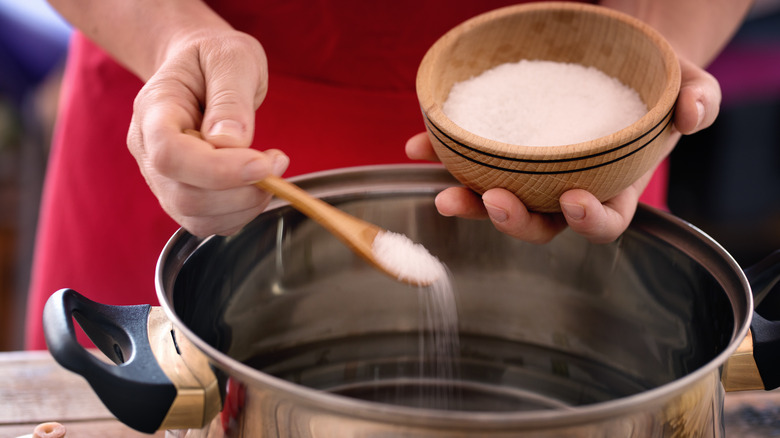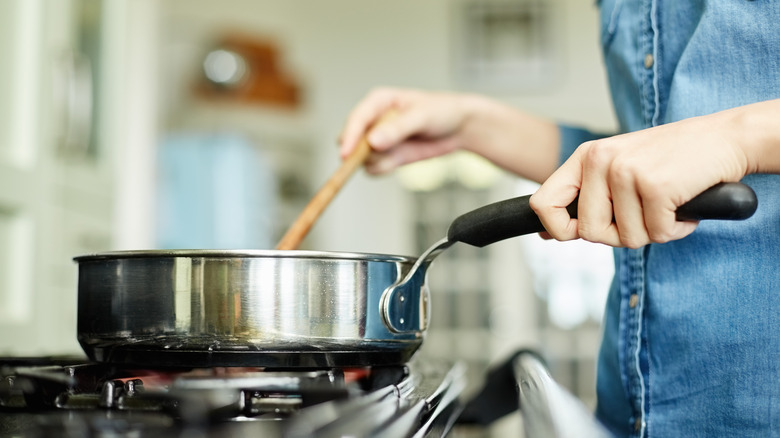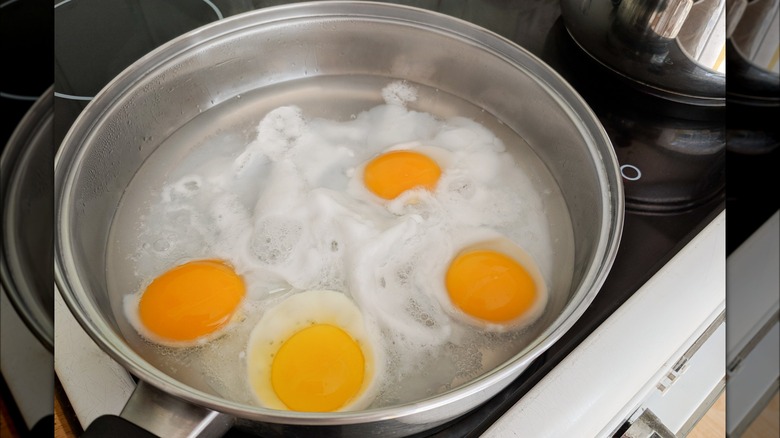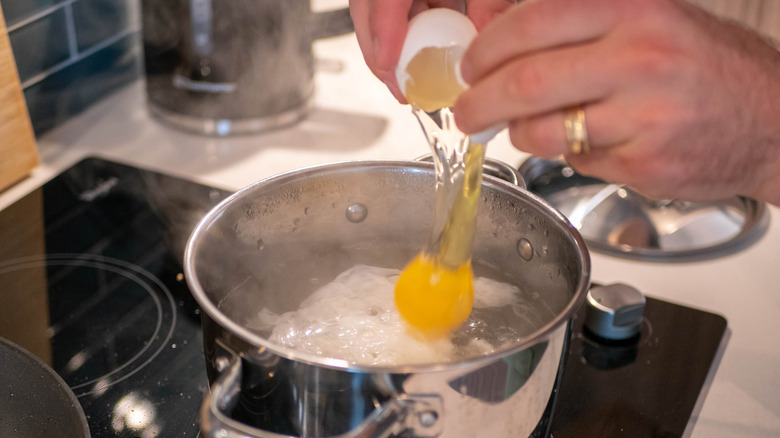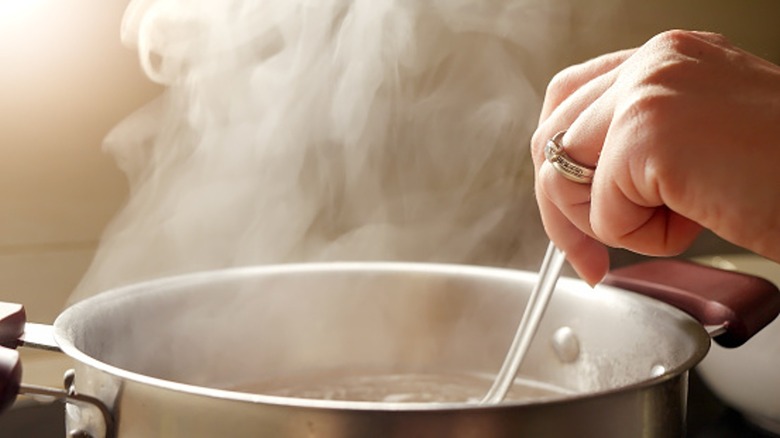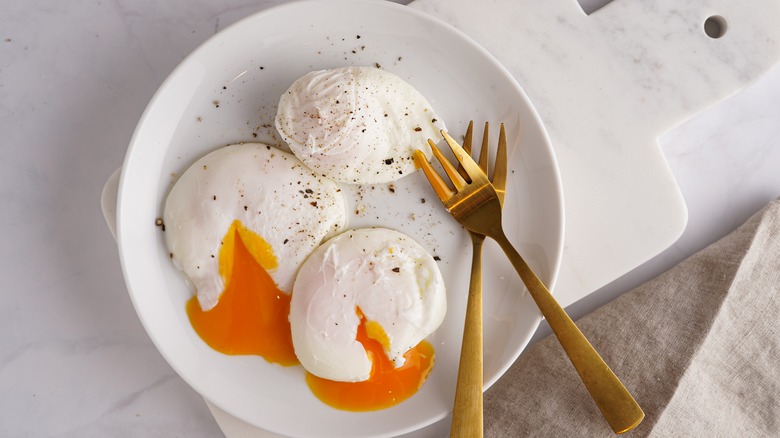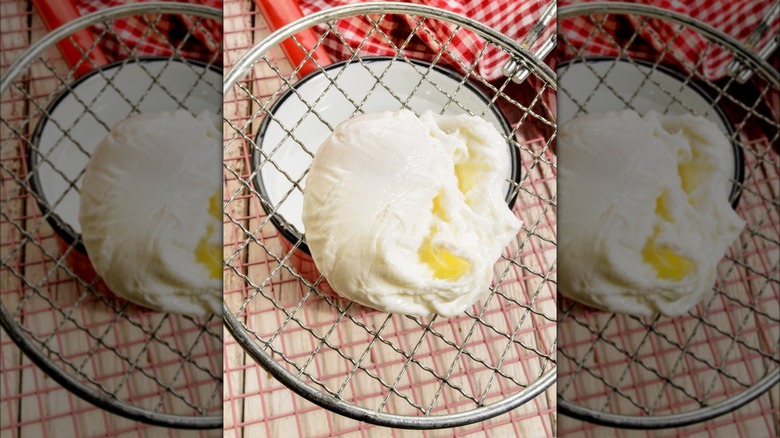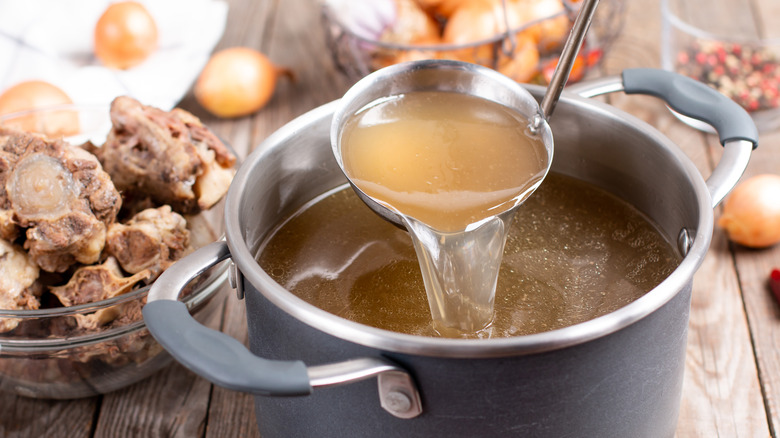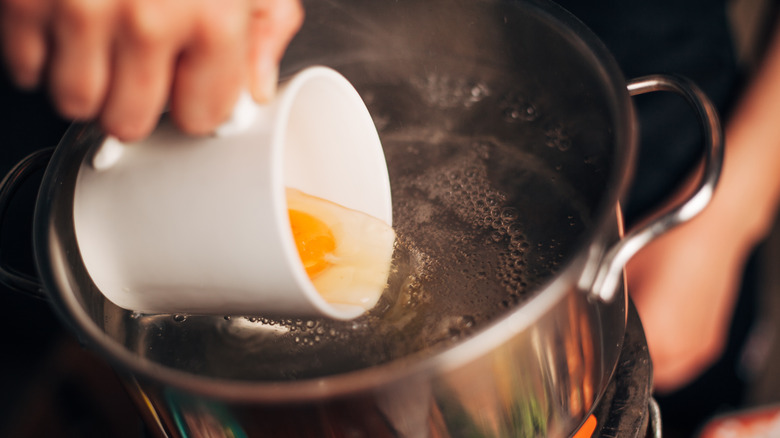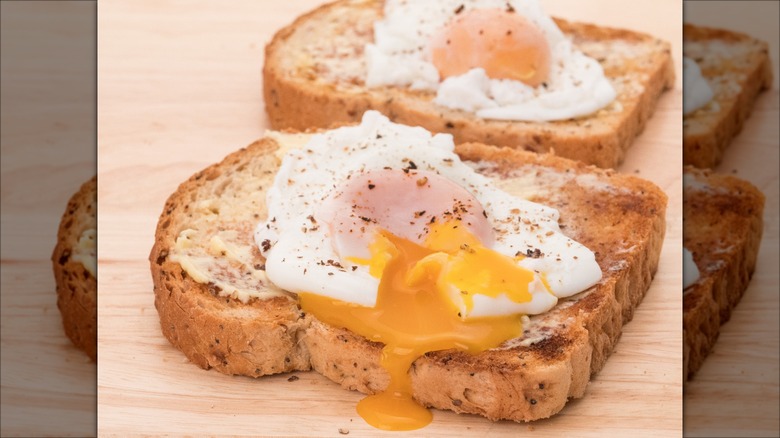14 Common Mistakes You're Probably Making When Poaching Eggs, According To The American Egg Board
There are many ways to cook an egg, and poaching may be the most delicate. While cooking poached eggs isn't rocket science, many people avoid making this breakfast or brunch dish at home and instead only order it at a restaurant. Some fear that they will ruin the dish — or perhaps they have made a mistake cooking poached eggs before and are afraid of replicating that disastrous outcome.
We spoke with Nelson Serrano-Bahri, a chef and the Director of Innovation at the American Egg Board, to learn more about poaching eggs and some of the most common mistakes people make when attempting to do so. If you have tried and failed to get poached eggs to turn out correctly, Serrano-Bahri's responses will give you the knowledge you need to try again. Say good morning to all the possible meals you can make with poached eggs, from eggs Benedict to poached eggs with avocado toast.
1. Not using fresh eggs
Don't make a mistake when choosing the right type of eggs to poach. While fresh eggs can make a difference in many dishes, Nelson Serrano-Bahri explains how they are crucial to use when preparing poached eggs. He says, "Fresh eggs make a huge difference, and you'll see it with how the poached egg comes together."
The extra trip to the grocery store — or your backyard coop — will be well worth the time. Whether the yolk is yellow or orange, it will be of higher quality in a fresh egg. This is because the yolk of a fresh egg sits higher up in the egg than that of an older one. This results in more of the egg white encompassing the yolk, compared to the thinner white around the yolk of an older egg. When you crack an older egg, the yolk is more fragile and more likely to break. Plus, the white is more likely to pull away from it as it cooks.
2. Using boiling water
Many people bring the water to a rolling boil when making poached eggs. However, according to Nelson Serrano-Bahri, the water shouldn't be brought to a full boil when poached eggs. While boiling water reaches a temperature of 212 degrees Fahrenheit, when poaching an egg, Serrano-Bahri explains, "You want the water to be at about 180-190 degrees [Fahrenheit]. If there are any bubbles, they should be very minor and shouldn't be causing any turbulence."
If the water is allowed to come to a full boil, it could spell disaster for your egg. There's a reason it should be at a low simmer and not a boil. The strong bubbles and moving water will crash into the delicate egg whites and yolks as they cook. This is likely to result in them breaking apart, leaving you with disastrous results. Instead of encasing the yolk as they should, the broken egg white will disintegrate into lots of little wispy pieces scattered around the pan.
3. Adding too much vinegar to the water
It's true that not using vinegar when preparing poached eggs can be a mistake. This is especially true if you want to poach eggs in bulk. Nelson Serrano-Bahri explains, "Vinegar protects the yolk by helping the eggs stay together when poaching." Because of its acidity, vinegar causes the egg white to denature (meaning it starts to solidify) more quickly, which helps it maintain its shape and encapsulate the yolk.
However, while vinegar can be an important component when poaching eggs, Serrano-Bahri cautions against adding too much to the pot of boiling water. He says, "I recommend adding 1 tablespoon of vinegar per every cup of water." Avoid adding more than this to make sure you don't alter the taste of the eggs. And more than 1 tablespoon isn't necessary, so you'll be wasting an ingredient you could use for future cooking or cleaning needs, such as your dishwasher.
4. Not seasoning the water
There is some controversy about whether you should add salt to the water when preparing poached eggs. According to Nelson Serrano-Bahri says, "A little bit of salt in the water will go a long way to making your poached eggs beautiful and delicious!" Others who share his opinion believe that adding salt to the water helps keep the egg from sinking to the bottom of the pan. Because it increases the density of the water, proponents of this method believe it allows the egg to float at the top of the pan when it has finished cooking.
However, not everyone shares this same reasoning. Some believe that the increased density of the water will result in the fragile egg white breaking apart. Instead of being neatly encased in egg white, individuals with this viewpoint say many pieces of wispy whites will spread throughout the pan. This is one of those tips you might need to experiment with a few times to see what works best in your kitchen.
5. Using a shallow pan
"When choosing a vessel to poach your eggs in, make sure it is deep and big enough to comfortably handle the eggs," advises Nelson Serrano-Bahri. The ideal pan size will vary based on the number of eggs you are cooking. Serrano-Bahri explains, "If you're cooking more than one to two eggs, you will need to use a bigger pan."
The key lies in choosing a pan that will hold enough water for the eggs to be fully submerged without rubbing against the base of the pan. They could stick or break apart if they touch the pan's bottom. Once you've selected a large and deep enough pot to accommodate the number of eggs you want to poach, add about 3 to 4 inches of water to the pan. This should be enough to cover the eggs as the cook, while still keeping them away from the bottom.
6. Adding too many eggs
When you're new to poaching eggs, you will probably want to stick to poaching just one at a time. If you try to poach too many at once, it will be hard to create a vortex — an essential tip described later in this list — for the new additions without breaking apart the egg white that is already in the pot.
With some practice, you may master the technique of poaching just one egg and feel ready to move on to poaching a few together. Still, Nelson Serrano-Bahri advises against trying to poach too many at the same time. He says, "You will want to add one egg for every one to 2 inches of the pan's height. The more comfortable those eggs are, the better results you'll see." Serrano-Bahri also says to ensure that you only add one egg to the poaching water at a time.
7. Cracking eggs directly into the water
If you've tried to make poached eggs before, did you crack the eggs directly into the poaching water? Well, this method is not like frying an egg, where you can just open up the shell above the pan for a quick sunny-side-up meal. For poaching, Nelson Serrano-Bahri recommends cracking the egg(s) into a rounded bowl, not directly into the pot (remember, you shouldn't wash them first). He explains, "This way, you can check that the egg is nice and beautiful once cracked with no leftover shells." If the yolk has broken, you can put the egg aside for another use and start over.
Add the eggs to the poaching water after you've cracked and inspected them. Serrano-Bahri says, "Once ready, tip the vessel into the water and slowly slide the egg in to begin the poaching process." This method may dirty an extra bowl, but it will also help you catch and remedy problems before they ruin your poached eggs.
8. Not stirring water before poaching
If you dump the cracked egg into the pan before stirring the water, you will regret it. Nelson Serrano-Bahri explains that stirring the water before pouring in the egg is necessary to create a vortex. Think of the vortex as a tornado in the water. Its spinning motion will keep all the components of the egg together. Making this mini tornado is simple. Just grab a spoon and gently circle it around the outside of the pan. You'll know it is ready once you see the water in the center spinning on its own.
Conversely, if you pour the egg into the pan without creating a vortex, nothing will prevent the egg whites from spreading out instead of wrapping themselves around the yolk. Serrano-Bahri highlights the magic of the vortex. He says, "Once stirred, add the egg into the vortex, and watch the egg come together into the iconic poached egg shape."
9. Not poaching them for the correct amount of time
Timing is everything when it comes to poaching an egg. As Nelson Serrano-Bahri shares, "The goal is for the eggs to have a bounce in the center when poaching." It is impossible to achieve this level of perfection if you don't let the eggs cook long enough or if you cook them longer than the recommended time. A Serrano-Bahri notes, "Cooking them for too short of a time will result in runny whites, while cooking them for too long will give you a hard center." Either way, you'll be disappointed.
Serrano-Bahri explains that poached eggs typically take between 2 and 3 minutes to be cooked and ready. He also highlights that you should not leave the eggs in the pan after they have finished cooking. Even if you remove the pan from the heat, the water will still be hot enough to continue the cooking process, causing the center of the egg to harden. To avoid this, remove the eggs from the hot water immediately after cooking, "put them through a strainer, dry them, and then serve."
10. Draining your eggs incorrectly
No one wants their poached egg to be covered in water, so it is important to know how to drain them properly after they've finished cooking. While many people recommend using a slotted spoon to remove the eggs from the pan and drain the excess water, Nelson-Serrano Bahri is not a fan of this method because it is likely to cause the egg to break.
Instead, he says, "Try using a more concave spoon that can cradle the eggs or a spider strainer when removing your eggs." After staining the eggs, they will still be a bit damp. If you want to dry them more before serving, follow Serrano-Bahri's advice to transfer them to a paper towel so more water will drain off. You can use a second paper towel to pat them dry gently. After this, you'll be much closer to being ready to enjoy the eggs.
11. Only using water to poach
When you're new to poaching eggs, stick to the tried-and-true method of using hot water. This will allow you to implement best practices and perfect your technique. However, once you have some experience, Nelson Serrano-Bahri recommends experimenting using other liquids to poach eggs. He explains, "Different types of liquid will result in different flavor profiles." This will allow you to "broaden the flavors and experiences when serving poached eggs to your guests," according to Serrano-Bahri.
The possibilities for liquids you can use are nearly endless. Why not try broth, wine, ale, milk, or even tomato soup? Think about the types of dishes you want to prepare using poached eggs and evaluate which flavors will enhance them. For example, an egg poached in white wine may make a nice addition to a French recipe, while poaching one in milk could add some creaminess to your meal.
12. Being impatient
Patience is a virtue. Now that's an insightful quote you can apply to many areas of your life. It is also extremely important when it comes to poaching eggs. Beyond the patience you'll need to wait for the egg to cook in the hot liquid you choose, Nelson Serrano-Bahri emphasizes the importance of patience as you learn how to prepare poached eggs.
He says, "Practice makes perfect when it comes to poaching eggs! Poaching eggs is a technique that takes time to get just right." You'll want to give yourself plenty of time to practice poaching eggs for yourself before you try to make complicated recipes to serve to guests. Likewise, you'll also want to ensure you're comfortable with the basics before experimenting with other flavors or liquids. Be sure to give yourself some grace, too. While poaching eggs may seem straightforward, as we've already explained, several things must go just right to achieve perfection. This is why practice is so important.
13. Not seasoning eggs before serving
"Just because we seasoned the water, doesn't mean we shouldn't season the eggs," says Nelson Serrano-Bahri. An unseasoned egg will taste too bland and be less enjoyable to eat. As for which seasonings you should use, Serrano-Bahri says, "Add some salt and pepper to the final poached eggs when serving." Beyond being a flavor enhancer, salt also helps to cancel out some of the bitterness, ensuring you genuinely enjoy the flavor of the egg.
Pepper also helps to take the flavor of the egg up a notch, adding a hint of spiciness. Did you know that the type of pepper you choose will impact the overall taste of the poached eggs? While black pepper is spicier and has a pinier flavor, white pepper is milder and more earthy. You can also experiment with other seasoning options matching your taste preferences and what you'll serve the poached eggs with. Some other options include paprika, garlic powder or garlic salt, chili powder, or chives.
14. Not serving them fresh
"You can batch them and reheat them later, but the reality is that a good poached egg is served fresh," explains Nelson Serrano-Bahri. If you are planning to make poached eggs for a meal, your best bet is to make them immediately before you want to serve them. You risk making the yolk too hard if you try to reheat a poached egg.
If you must make the poached eggs in advance or have a few left from a previous batch that you want to save, knowing how to reheat them properly is important. Avoid using the microwave to reheat the eggs. Instead, heat a pot of water on the stove. Once heated, take it off the heat and gently place the poached eggs in the water. Leave them sitting for 30 seconds to one minute. Remove the eggs, pat them dry, and serve them promptly.
